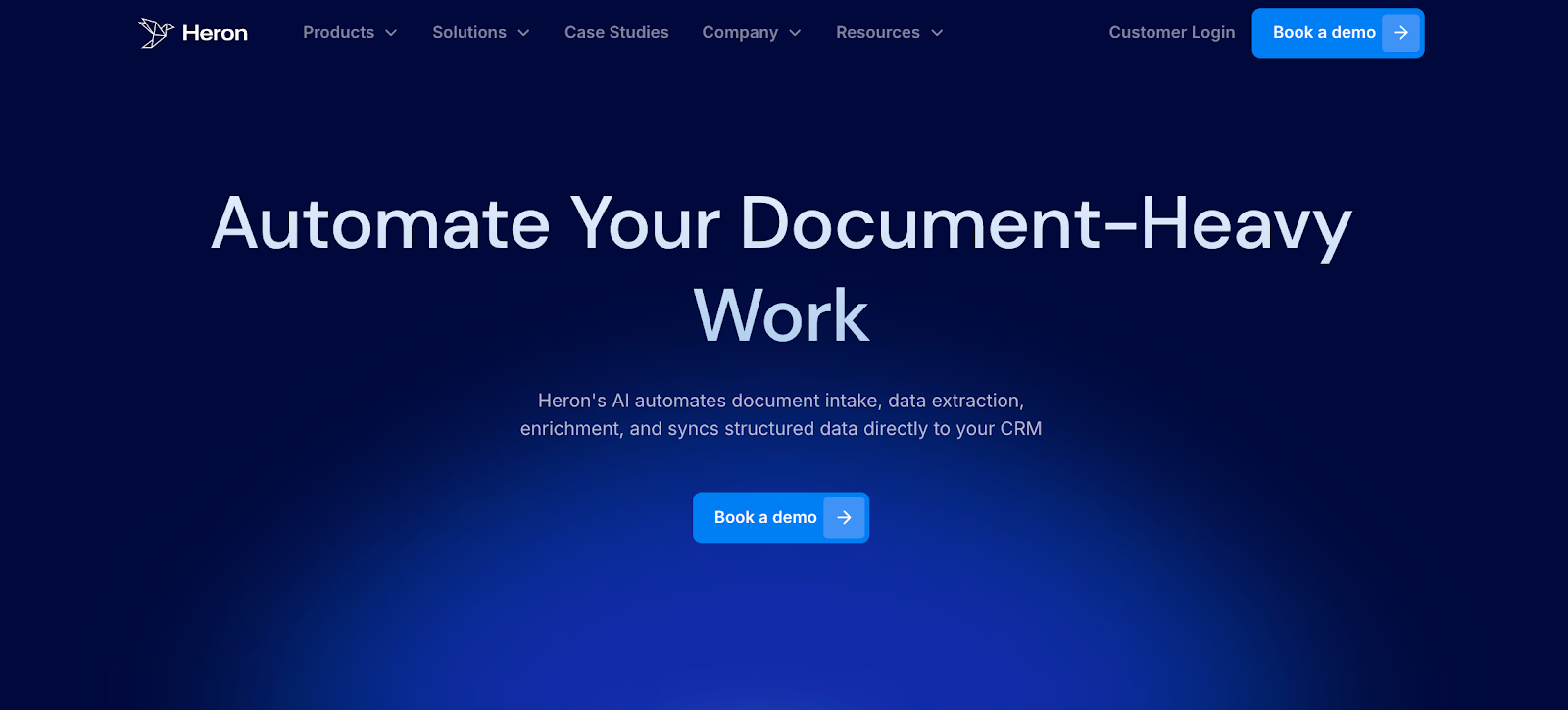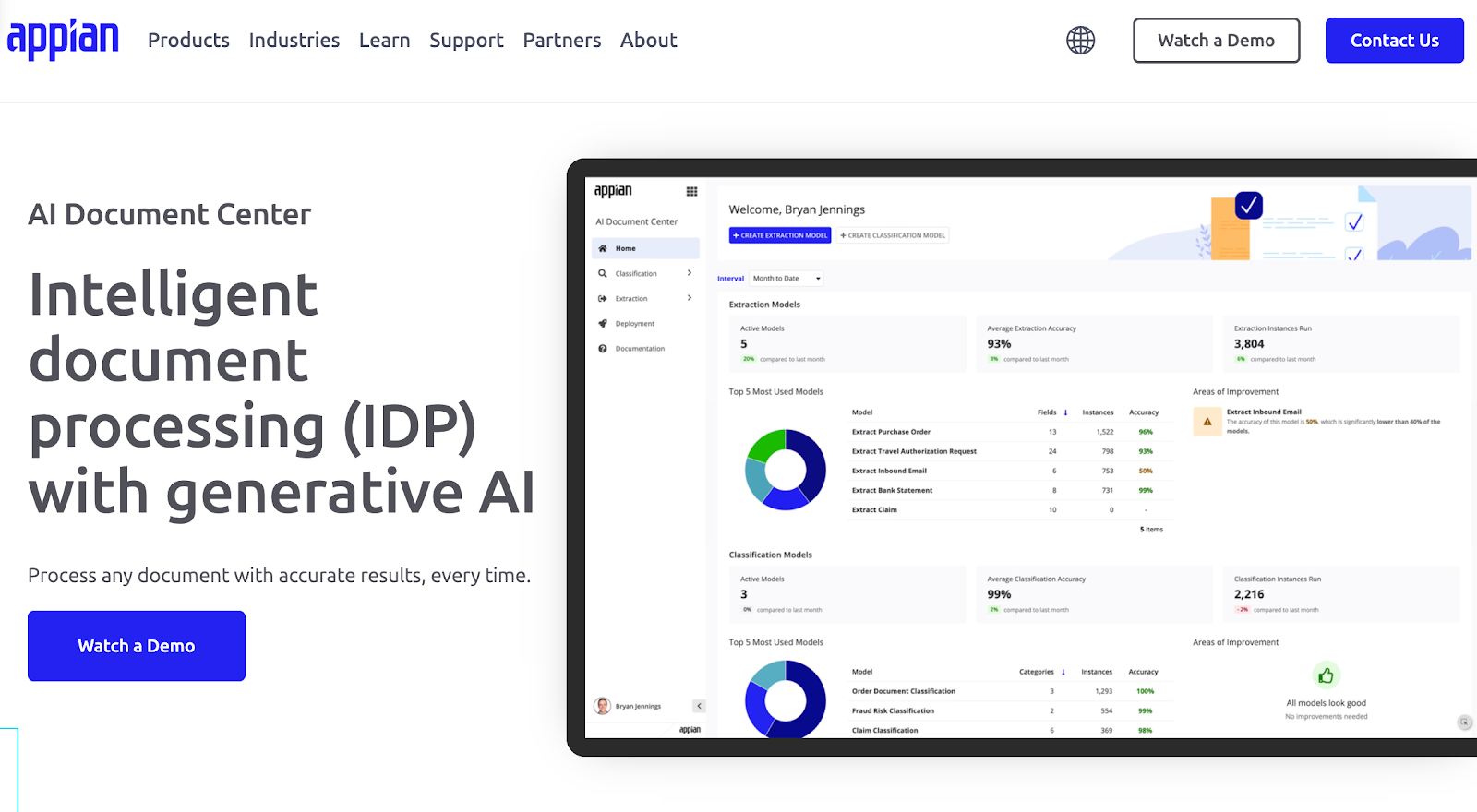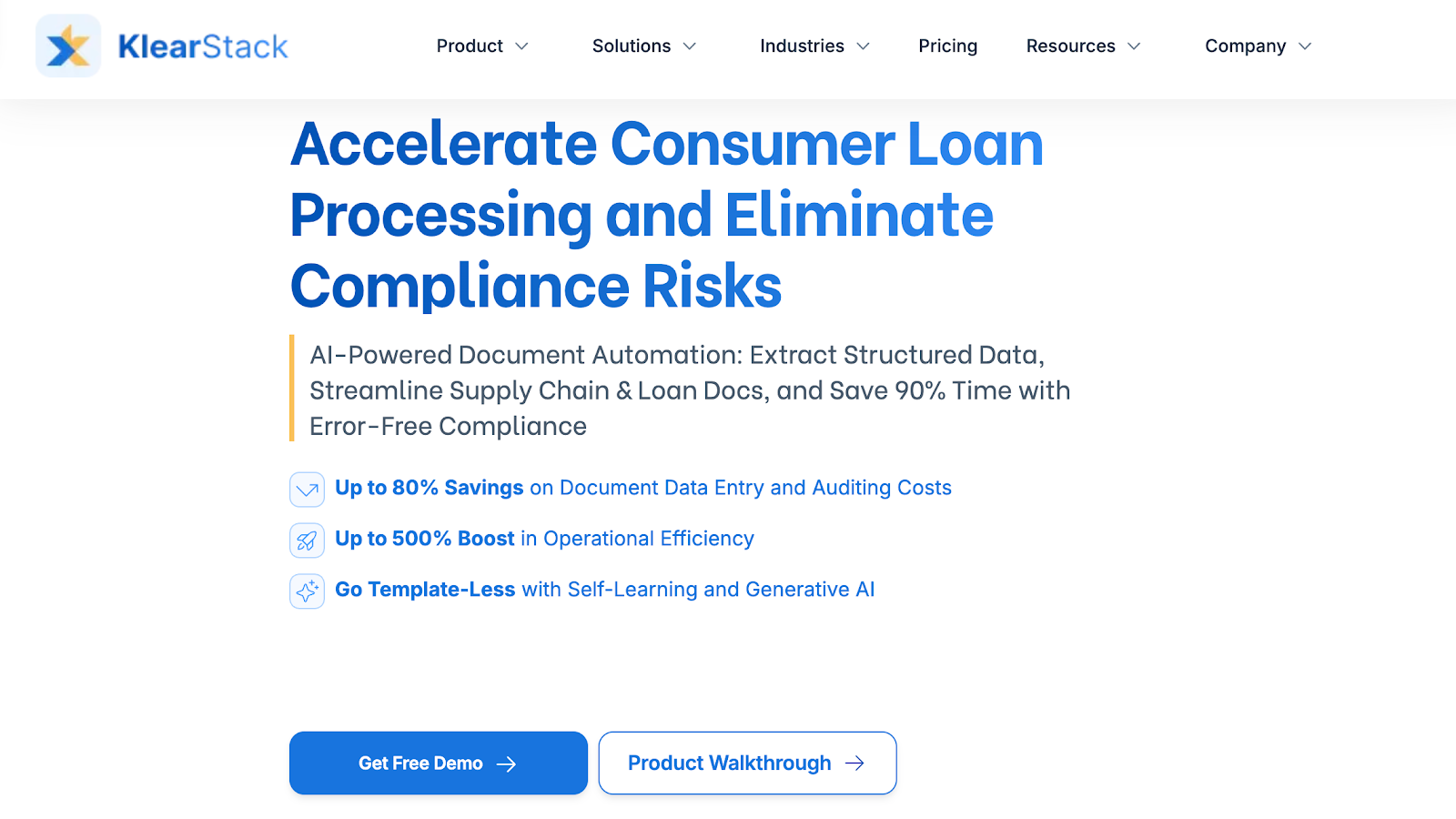Funders often turn to Ocrolus to handle financial documents because manual review is slow, costly, and prone to errors.
Manually pulling data from business bank statements, tax forms, and receipts takes valuable time away from underwriting and slows down funding decisions.
While Ocrolus helps automate parts of this process, some funders still face challenges with processing speed, cost, and flexibility.
In this article, we’ll walk through the five top Ocrolus competitors every funder should consider. Each one offers different strengths that could be a better fit depending on your business needs.
What Is Ocrolus, And Why Are Funders Switching?
Ocrolus is a document AI platform built to handle financial documents. It can extract data from files such as business bank statements, pay stubs, and tax forms.
Financial institutions use it to make decisions faster and with more accuracy. Automating financial document processing supports business processes that once took hours of manual review.
Many funders and brokers use Ocrolus because it reduces the strain of manual work. It also adds fraud detection tools that help teams spot altered documents before they become a problem.
However, as much as Ocrolus has proven itself viable, some funders are choosing to switch to other document automation tools.
But why? Here are a few reasons we can outline based on the platform's reviews on G2, a software product review website.
Processing Speed Can Vary
Some users report that results do not always arrive at the same pace. While the platform can return data extraction in minutes, heavy loads or certain formats may cause delays.
For funders working with tight deadlines, even small delays in reviewing bank statements can affect loan processing timelines.
Limited Flexibility In Reporting
Funders often want to extract data in a way that fits their own business processes. While Ocrolus allows exports, some reviews mention that self-service reporting options feel limited.
This means teams may need to adjust their workflows instead of shaping the reports around their exact needs.
False Positives In Fraud Detection
Fraud detection is one of Ocrolus’s stronger features, but some users have noted that the system can return a false positive on certain documents.
For funders, this can mean extra manual checks to confirm whether the alert is valid. While it adds a layer of safety, it may also slow down decisions.
Variability With Complex Financial Documents
The platform automates most financial documents with strong accuracy, but users have pointed out that very large files or unusual layouts can slow things down.
For example, when processing a bank statement that runs over 100 pages, the system may take longer to extract data and deliver results. This becomes more noticeable for financial institutions that handle bulk submissions every day.
In those cases, delays can affect overall financial workflows and make it harder to keep loan applications moving at the pace funders expect.
Human-In-The-Loop Discrepancies
Ocrolus combines automation with human review to keep results accurate. This model works well in most cases, but a few users noticed that human reviewers can introduce small inconsistencies in data extraction.
These discrepancies are not common, yet when they happen, funders may need to double-check the outputs before using them in business processes.
For underwriting teams that rely heavily on precise financial document processing, even small differences can add extra review time.
Cost Concerns
Some reviews also raised questions about pricing. While many funders believe the time saved and the accuracy provided make the platform valuable, others feel the costs could be adjusted, especially for smaller firms with tighter budgets.
Larger financial institutions may absorb the expense more easily, but smaller brokers and funders might look for a more accessible option.
5 Ocrolus Alternatives You Need to Know in 2025
Below are five Ocrolus alternatives you should know in 2025.
1. Heron

Heron helps high-volume MCA funders and brokers move faster without adding staff. The platform takes messy, unstructured documents and turns them into clean, structured data in just seconds.
It automates application intake, financial records review, and funder decision emails so your team can focus on underwriting and closing deals instead of manual data entry.
Heron plugs directly into your existing CRM, which means no costly rebuilds. Built specifically for MCA and lending workflows, it gives clients accuracy, speed, and scale.
With Heron, paperwork no longer slows you down. You fund more deals with the same team.
Key Features
- Automated document intake - Process unstructured documents instantly and send structured data to your CRM
- Financial data scrubbing - Identify and parse financial records, including business bank statements, tax returns, and contracts
- AI-driven enrichment - Add context to client files with machine learning and third-party data sources
- CRM integration - Sync structured data directly into your system of record without extra steps
- 50+ document types supported - Handle more than 50 document types off the shelf, with new formats added regularly
- Secure compliance - Keep client and financial data protected with SOC 2 and GDPR standards
- Industry-specific workflows - Get automation built for MCA and loan processes, not generic tools
2. Appian

Appian is an intelligent document processing (IDP) technology that uses generative AI to handle unstructured documents and create structured data.
It is designed to read different document types, extract information with accuracy, and integrate results into enterprise workflows.
The platform provides a no-code setup, allowing teams to configure extraction and classification rules without technical skills, while maintaining security and compliance standards for sensitive data.
Key Features
- Document processing - Use generative AI to extract and classify information from unstructured documents and financial records
- Workflow integration - Embed document processing technology into enterprise workflows to route tasks between AI agents, bots, and people
- No-code configuration - Create and manage extraction models, validation steps, and post-processing rules without coding
- Model refinement - Improve accuracy through guided prompt engineering and model reconciliation with test cases
- Security and compliance - Maintain auditability and control with enterprise-grade architecture designed for safe handling of client data
3. KlearStack

KlearStack AI is an intelligent document automation platform designed to process consumer loan documents and related financial records.
It converts unstructured documents into structured data to support faster loan approvals, compliance checks, and cost reduction.
The system is built to handle high document volumes, integrate with existing loan management or ERP systems, and reduce manual data entry through AI-driven extraction and validation.
Key Features
- AI-powered data extraction - Extract structured data from unstructured consumer loan documents, regardless of format or quality
- Automated compliance checks - Identify discrepancies and flag potential regulatory issues in real time
- Integration-ready - Connect with loan management systems, CRMs, and other enterprise platforms
- Scalable document handling - Process large volumes of financial data consistently and with high accuracy
- ERP compatibility - Support end-to-end workflows by integrating with leading ERP systems
4. SOLO

SOLO is a document automation platform for credit and underwriting back offices. It is designed to process paperwork, extract data, and activate workflows across connected systems.
The platform ingests unstructured documents such as contracts, tax returns, and PDFs, applies custom logic to standardize the data, and then triggers decisions, reports, and rules.
With support for thousands of integrations, SOLO enables credit teams to reduce manual copy-and-paste tasks and move from document intake to decision-making in minutes.
Key Features
- Automated data extraction - Capture and standardize data from contracts, tax returns, PDFs, and other financial documents
- Workflow activation - Trigger rules, workflows, and decisions based on extracted data in real time
- Integrated calculations - Run calculations and build reports directly on top of uploaded documents
- System connectivity - Sync with over 4,000 compatible integrations to connect data across operating systems
- Custom document intelligence - Apply logic and AI to classify documents and extract only the required details
5. Extend

Extend is a document automation platform designed to process unstructured documents and convert them into structured data for financial operations.
It supports a variety of use cases, from onboarding and underwriting to tax processing, payments, and claims management. Built with multiple language models, Extend provides flexibility in balancing cost, performance, and speed.
The platform is enterprise-ready with built-in compliance, monitoring, and security features to support large-scale document processing.
Key Features
- Comprehensive toolkit - Handle ingestion, extraction, classification, splitting, and fraud detection across multiple document formats, including PDF, CSV, IMG, XLSX, and DOCX
- Model flexibility - Compare and deploy different large language models to optimize performance, cost, and latency
- Production-grade reliability - Use monitoring, observability, version control, and performance dashboards for stable operations
- Enterprise security - SOC 2 and HIPAA compliance with audit logs, encryption, and granular data retention controls
- Scalable document automation - Process financial, tax, claims, and payment documents with support for high-volume use cases
What Should You Look for in a Document Automation Platform?
Reviewing financial documents is part of everyday operations for funders. A strong document automation platform helps make this process faster, more accurate, and more secure.
But not every tool offers the same capabilities. When choosing software, it’s important to know which features matter most for handling transactions, protecting sensitive information, and improving operational efficiency.
Below are the key features you should focus on.
Advanced Data Extraction With High Accuracy
The best platforms use artificial intelligence and optical character recognition (OCR) technology to read and extract data from complex financial documents like balance sheets, tax returns, or income statements.
This reduces reliance on manual entry, which often introduces errors. For example, instead of staff retyping values from receipts or hundreds of business bank statements, the system can capture the data automatically.
Pre-Trained AI Models Specifically For Financial Documents
Pre-trained AI models built for finance reduce the need for constant adjustments. They can validate data, recognize malformed data, and highlight discrepancies in real time.
This is especially helpful when processing large batches of tax forms or receipts where even small mistakes could affect loan decisions.
By having models ready to handle these scenarios, funders avoid setting up custom rules from scratch every time.
Ease Of Use For All Teams
A user-friendly interface is key, especially when non-technical users need to run several actions without deep training.
The right platform should make it easy to upload documents, review scrubbed data, and export results with minimal effort.
For example, a broker should be able to import bank statements, run data checks, and move the information into reports without relying on IT support. This kind of design saves time and encourages adoption across different teams.
Support For Multiple Document Formats
Funders regularly deal with business bank statements, tax returns, and other records. The software should process all of these formats consistently.
If a client submits both digital PDFs and scanned images, the system should still extract data accurately.
This capability is especially useful because financial institutions receive documents from many sources and cannot always control how those files are delivered.
Integration Capabilities with Your Existing Systems
An effective platform should easily connect with your existing ERP, CRM, or accounting software so that validated data flows directly into financial workflows.
This reduces the need for double entry and improves operational efficiency. For example, extracted income details from bank statements could feed directly into credit risk models.
Integration also makes version control easier, since teams can access the latest validated data without pulling it manually from different systems.
Strong Security Features
Since funders handle sensitive financial data, the platform must include a reliable security service. This means encryption, access controls, and tools that protect against online attacks.
A strong security solution should also support audit logs and compliance requirements. By investing in these safeguards, funders can strengthen compliance while keeping transactions and customer records protected.
Scalability For Growth
The platform should grow with the business. As document volume increases or new regulations emerge, the system should adapt without losing speed or accuracy.
For example, a broker who starts by processing a few hundred documents a month may scale to thousands over time. Scalable platforms can handle this shift without forcing a system change.
Audit Trails For Compliance And Oversight
Audit trails keep a record of several actions, from uploading to editing and exporting. For funders, this is critical for fraud prevention and regulatory reviews.
If a question comes up about how a document was processed, a clear trail shows who handled it and when.
This helps protect the institution, strengthens compliance, and provides transparency during internal or external audits.
From Inbox Chaos To Decision-Ready Data with Heron

Heron gives MCA funders and brokers a faster, more reliable way to work with financial and other documents.
Manual entry slows down deals, but Heron’s automation tools scrub, enrich, and validate data at every step. This helps reduce errors, improve accuracy, and cut turnaround times from days to minutes.
With Heron, teams focus on underwriting, not admin. Funders can cut processing costs by over 75%, respond to clients in hours rather than days, and handle 2x the volume without adding headcount.
For funders working with small businesses across various industries, Heron makes the review process smoother by syncing structured data straight into your systems.
FAQs About Ocrolus Competitors
Who are the competitors of Ocrolus?
Some of Ocrolus’s rivals include ABBYY and KlearStack. These companies also provide document automation and intelligent data capture tools that use AI to process and analyze financial and business documents.
For funders looking for a specialized tool, Heron is much more suitable. Heron helps high-volume MCA funders and brokers handle applications, business bank statement analysis, and funder decision emails with automation built directly into their existing systems.
What type of company is Ocrolus?
Ocrolus is a fintech company that uses AI to read and analyze documents like receipts and invoices, helping businesses process data faster and more accurately.
Who owns Ocrolus?
Ocrolus is a private company, and its ownership comes from venture capital investors, though a site owner or single founder does not fully control it.

![5 Top Ocrolus Competitors Every Funder Should Consider [Key Features Reviewed]: 1. Heron 2. Appian 3. KlearStack 4. SOLO 5. Extend](https://cdn.prod.website-files.com/6759b60b29bf1f17d2f1e5ec/68ff11ffedefe9b3e527d848_ocrolus%20competitors.png)
